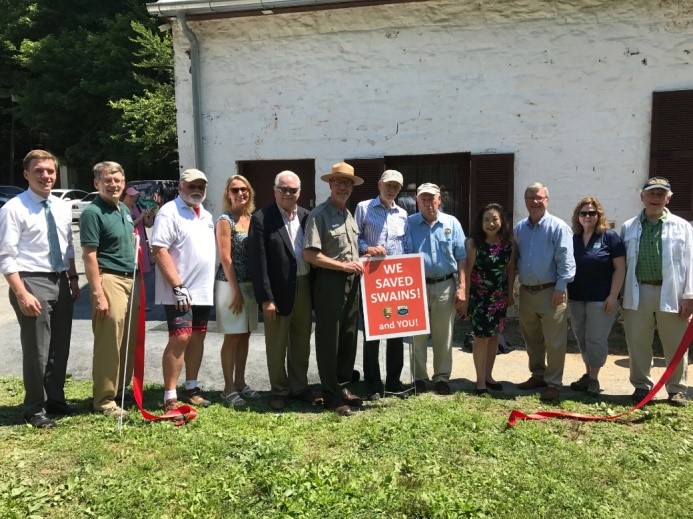
Swains Lockhouse is officially open! After an intensive rehabilitation, Swains Lockhouse has joined the award-winning Canal Quarters program and is available to guests for overnight stays.
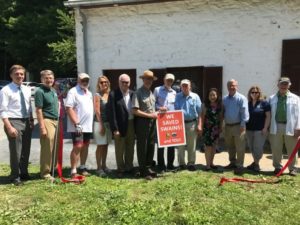
July 2019 ribbon cutting at Swains (Image: C&O Canal Trust)
There are now seven lockhouses in the program, and each contains special furnishings and details that tell the story of the C&O Canal’s history. Swains depicts 1916, but includes a mix of both traditional and twenty-first century features like a modern oven and stovetop (that only looks like a wood stove) and electricity. If you’re visiting during Maryland’s hot and humid summers, you will enjoy the air conditioning, something that the lockhouse did not have prior to the rehabilitation.
Scrapbooks and wall hangings in the lockhouse educate guests on the year 1916: The U.S. was poised to enter World War I, President Woodrow Wilson was re-elected, the women’s suffrage movement was underway, the first woman was elected to Congress, and the National Park Service was established.
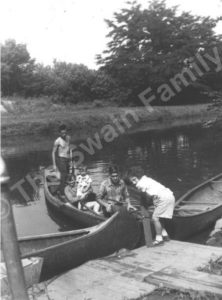
Two Swain siblings with guests renting canoes in the 1950s (Image: Bert Swain).
In addition to the 1916 interpretation, the lockhouse tells the story of the Swain family, generations of whom lived and worked on the C&O Canal and who are part of its history. Swain ancestors helped build the canal and owned and operated a fleet of canal boats, before transitioning to lock keepers living at Lockhouse 21 as the business of the canal evolved. After the canal closed to boat traffic in 1924, the Swain family started a concession business at Lock 21, providing guided trips, fishing gear, and boat and bike rentals to guests until 2006 .
The family lived in the lockhouse for 99 years, and Bert Swain, a C&O Canal Trust Board member who grew up in the house, credits this longevity with the lockhouse’s preservation. While other C&O Canal lockhouses and structures crumbled, the family cared for their home, which ultimately preserved this vital link to the past. With renovations complete, Bert Swain viewed his rehabbed childhood home with amazement, remembering his “magical upbringing” in which “every day was a different adventure.”
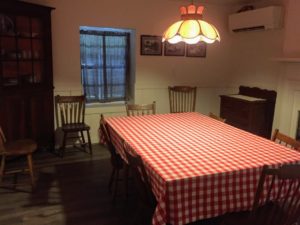
The large table in the dining room is perfect for meals and meetings. (Photo: Christine Rai)
Touring the Lockhouse
The front door leads to the 1880s portion of the lockhouse which is furnished as the dining room, dominated by a large table and chairs, with a corner curio cabinet, sideboard, and a fireplace creating a homey space.
An antique clock perched atop the mantel is flanked by a C&O Canal bugle that was used by an approaching boat captain to alert the lockkeeper of his approach. Historic photos of canallers hang on the walls, accompanied by interpretive text and questions to encourage discussion: “If you lived in 1916, would it have been acceptable to you to have your child work in a factory? In the coal mines? On the canal? Why or why not?” The C&O Canal Crier News, a newsletter full of local and national news from 1916 lies on the the windowsill.
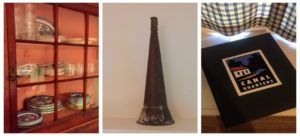
Savor meals atop antique china, check out a Canal horn, and share memories in the guest book. (Photos: Christine Rai)
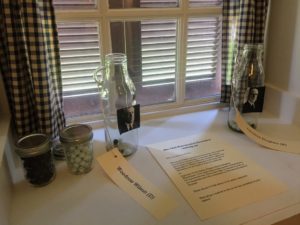
Review the candidates’ credentials and cast your vote. (Photo: Christine Rai)
The next room is an ADA-accessible bedroom, with a Murphy bed and an accessible bathroom attached. Framed diagrams for the original 1916 Murphy bed patent are displayed on the wall above the bed. The bathroom contains modern conveniences that would not have been in the lockhouse for much of its active use: a toilet, sink, and shower. As a reminder of the Swain family’s experiences, a framed watercolor of the outhouse the family used until 1962 hangs on the bathroom wall. An interactive windowsill display allows guests to vote for presidential candidates Wilson or Hughes by placing a marble in a milk bottle.
The vintage-style kitchen sits at the far end of the house, filled with a mixture of reproduction and authentic furnishings. What appears to be a mid-19th century wood stove turns out to be quite high tech, its digital key pad hidden from view. Prior to the installation of plumbing, the Swains’ bath water was heated on the original stove. The fridge is hidden behind a Shaker-style cabinet door, and the soapstone counters are from the only remaining soapstone quarry in the United States. An old washboard sits on shelving by the authentic enamel sink, and drawers are filled with utensils that could have been in a kitchen in 1916.

The kitchen is a mix of old and new elements. (Photos: Christine Rai)
On display are old irons, vintage cookbooks, and interpretive text about women’s work and the invention of the flyswatter. A small rectangular table illuminated by a green and yellow glass lamp completes the kitchen setup. An ADA-accessible picnic table and a firepit sit outside for guests who would like a more rustic cooking experience.
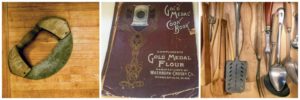
The kitchen has plenty of accoutrements to use and learn from. (Photos: Christine Rai)
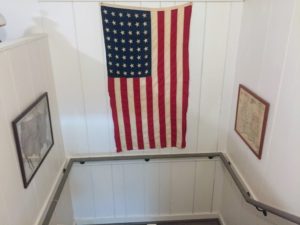
The stairwell invites visitors to reflect on how our nation and Montgomery County were different in 1916. (Photo: Christine Rai)
In the stairwell hangs a 1916-era American flag, missing stars for Alaska and Hawaii, and framed 1916 maps for the United States and Montgomery County. At the top of the stairs is a comfortable sitting room – that was once Bert Swain’s childhood bedroom — with a velvet couch and chairs. Original details remain, such as the floors, patched with metal in some spots, doors retaining their beautiful old patina and skeleton keys, and a plexiglass window that shows the historic wall surface.
A toy box with toys from the era encourage children to explore, while a scrapbook of 1916 history and framed photos of the canal and members of the Swains family provide diversion for adults. In one windowsill rests a tribute to Jimmy the Goose, Jesse Swain’s loyal and beloved pet goose of 27 years.

Swains’ upper floor offers fun and relaxation. (Photos: Christine Rai)
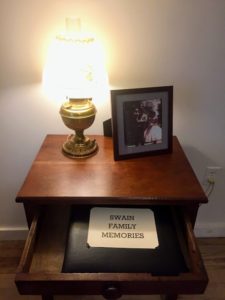
Open this drawer to be transported back in time, courtesy of the Swain family. (Photo: Christine Rai)
Two bedrooms flank the sitting room, the upstream bedroom featuring a washstand, vintage kids’ books, and two trundle beds. The downstream bedroom has a beautiful full-size bed. In Alice-in-Wonderland style, a hangtag on a dresser drawer invites visitors to peruse the Swain family album, full of beautiful images and amazing memories, generously shared by Bert Swain.
The C&O Canal National Historical Park that surrounds Swains Lockhouse is full of outdoor recreation opportunities. “Here we are, 30 minutes outside of the center of Washington D.C, and all we’re hearing is water and wildlife,” Bert Swain said. “The fact that other folks will be able to enjoy the house overnight and see what it was like to be here on the canal, I think it is just great. I’m really happy we were able to accomplish this.”

The C&O Canal promises relaxation and rejuvenation (Image: “Serene Beauty at Violettes Lock,” Peter Moreno).
Book your stay at Swains Lockhouse now.
Read more about the history and renovation of Swains Lockhouse at https://www.canaltrust.org/category/swains/.
Guest blogger Christine Rai is a college professor in the Washington, D.C. area with a passion for culture, food studies, and experiential learning. She writes about food, travel, and teaching at www.christinerai.com.





